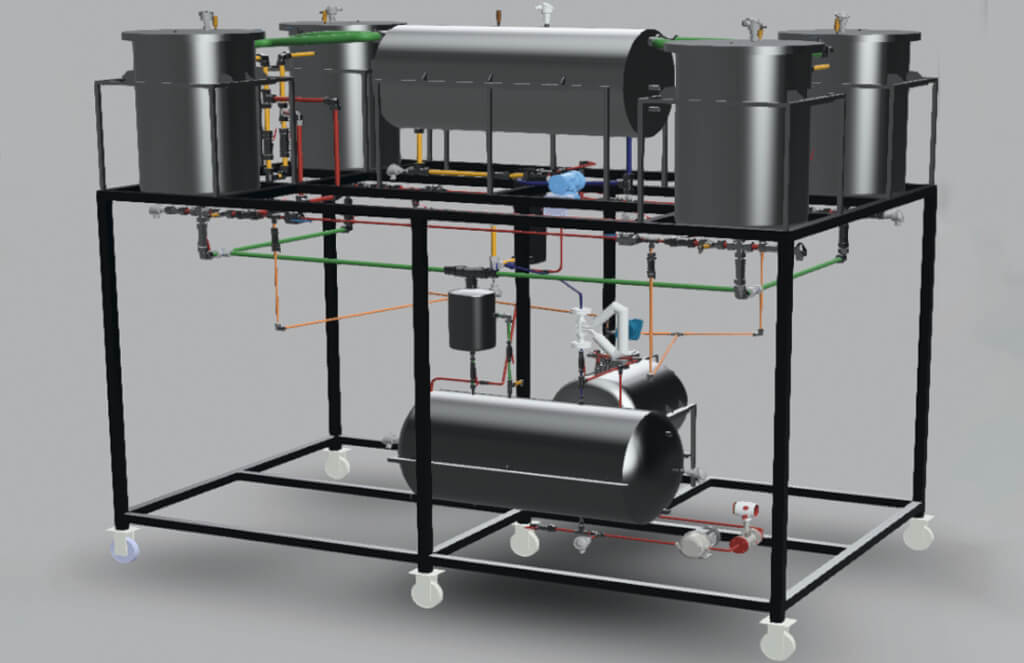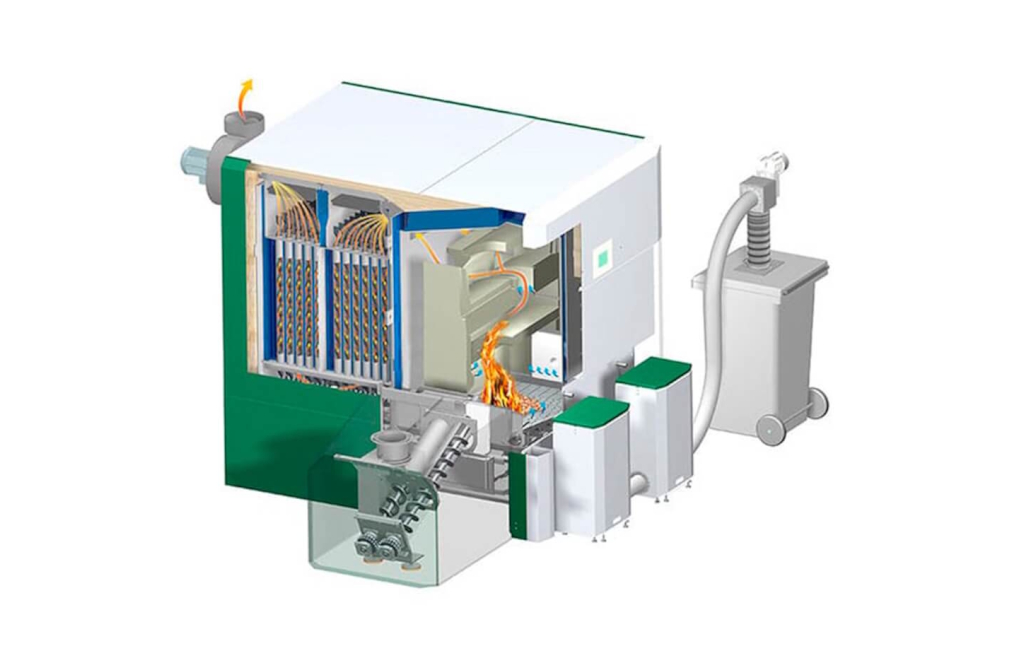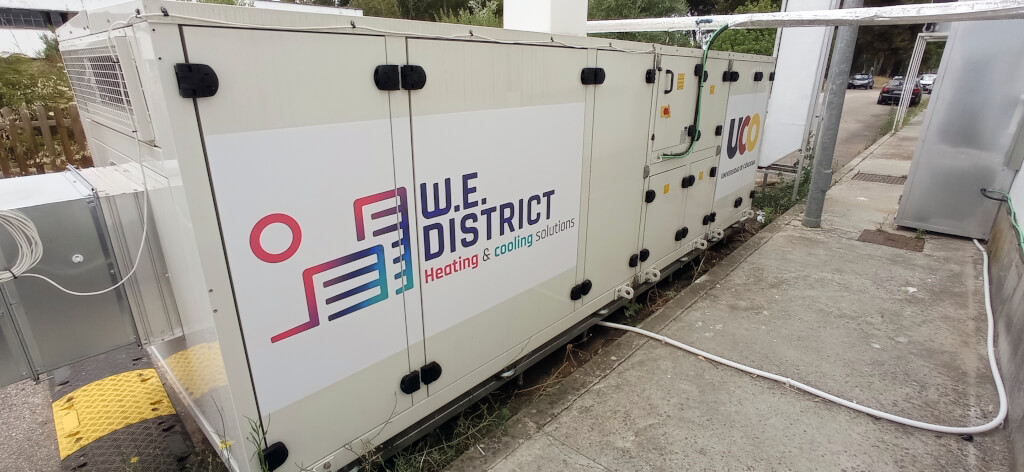WeSSun, tracking concentrator with fixed tilt collector.
With extreme temperatures persisting across Southern Europe, the EU-funded WEDISTRICT project is leading efforts to transform heating and cooling systems into fully renewable networks. In Córdoba, Spain, this initiative integrates solar, biomass, and innovative air-cooling technologies to meet energy needs sustainably. By reducing fossil fuel reliance and enhancing energy efficiency, WEDISTRICT showcases a scalable model for green infrastructure across Europe.
By Rebecca Pool, Freelance science and technology journalist
As the scorching Summer of 2024 drew to a close across the southern half of Europe, numerous cities towards the south of Spain were still braced for more extreme heat. In early September, Granada, Seville, Malaga and Córdoba – to name but a few – were set to record temperatures of at least 33ºC. This persistent heat, linked to human-caused climate change, highlights yet again the clear need to install more renewable energy generation, including heating and cooling solutions – and this is where European Union-funded €15 million-plus WEDISTRICT project has already been making a real difference.
Right now, heating and cooling of buildings accounts for half of the EU’s energy consumption, of which 70% is generated from fossil fuels. However, since launching in 2019, WEDISTRICT has developed and demonstrated renewable energy-based technologies for district heating and cooling (DHC) systems at three sites – Luleå, Sweden, Bucharest, Romania, and importantly for those that have sweltered in southern Europe, Córdoba.
The renewable DHC network in Córdoba covers the heating and cooling demands of several buildings at the Rabanales Campus of the University of Córdoba. Three different solar thermal technologies provide heating as well as cooling, via absorption chillers and a Renewable Air-Cooling Unit (RACU) prototype developed at the University. Heat from these solar thermal technologies is stored in a thermal energy storage tank, also part of the network.
In addition, two 500 kW biomass boilers have been integrated to the network for thermal generation, making use of nearby biomass sources including olive stone, fruit shells and wood chips. And critically, an open-source intelligent energy management system controls all renewable energy generation, storage, transformation and distribution across the entire DHC network.
Technology integration
For key WEDISTRICT project members, Miguel Herrador Moreno of renewable technology development firm, Aalborg CSP, and Professor Manuel Ruiz de Adana, University of Córdoba, integrating the numerous renewable technologies to the DHC network has been a significant innovation. “We wanted to demonstrate that you could build and economically operate a DHC network in a 100% renewable way,” says Ruiz de Adana. “A key challenge [in the beginning] was to see which combination of these technologies would provide the most energy-efficient and economic Heating, Ventilation and Air Conditioning (HVAC) service to our group of buildings all year round.”
On the solar side, three different concentration solar collector technologies – the parabolic trough collector, the linear Fresnel collector and the flat plate collector – have been trialled. Together these can generate just over 500 kWth thermal power.
According to Herrador, the flat plate collector uses an autonomous, solar-powered tracking system to move the collectors, so they always face the sun, thereby optimising thermal energy production. “These different solar thermal technologies are really interesting,” he adds. “On the one hand we have the [more established] parabolic collectors and the Fresnel collectors, but then we have the flat-plate collector which uses a [different] system of mirrors [to absorb more solar radiation].”
In a similar vein to Ruiz de Adana, Herrador reckons that integrating these technologies has been one of the most innovative, and complex, parts of the project. “What we’ve wanted to see, is how the technologies interact with each other – how they work, how they function, how they operate,” he explains. “We really want to understand operating characteristics so the new technologies can then be implemented in commercial plants.”
Cool moves

Ruiz de Adana also highlights the importance of the DHC network’s two absorption chillers and RACU; with a total power rating of more than 450 kW, these systems efficiently cool the hot water coming from the district network. “This means that at any time we can supply buildings with both hot and cold water from renewable energy sources,” he says.
María Jesús Romero, PhD student at the University of Córdoba, was instrumental in developing the RACU prototype, a hybrid renewable air-cooling system that works exclusively with outside air, and controls both air humidity and temperature without using refrigerants. Here, the outside air enters the system and passes through a desiccant wheel to remove excess moisture, controlling the humidity of the supplied air. The air can then pass through a dew-point evaporative cooler, to be cooled ready for supply to the building. And the system also has a ventilation loop to improve indoor air quality.
As Romero points out, during a recent heatwave in Córdoba when temperatures reached 43°C, the RACU cooled air temperatures to 17°C – conventional equipment would struggle to achieve this level of cooling. She also believes the prototype is truly innovative as it offers robust control over air humidity and temperature, as well as ventilation, unlike conventional air-conditioning equipment that typically controls temperature only.
“A main advantage of the system is it uses 100% outside air compared to conventional systems, that rely on a high percentage of recirculated air,” she says. “So with this, we are reducing environmental impact with a highly sustainable technology that maintains indoor air quality and provides thermal comfort inside any building.”
All in all, the carbon dioxide emissions associated with cooling from the Córdoba DHC network are expected to be 80 to 95% lower than those from today’s conventional air conditioning systems. “The biggest challenge we set ourselves when we set out to build this WEDISTRICT pilot plant was the challenge of combining all of its technologies and operating them efficiently,” says Ruiz de Adana. “[But we have now been] obtaining results that can be applied to other neighbourhoods across Spain and the rest of southern Europe.”
Ruiz de Adana is also certain that operations at the Córdoba pilot plant can be easily scaled up to serve a greater number of buildings, neighbourhoods and even regions of a city. “We have this leading facility, which we refer to as a living laboratory… [It] provides a way for us and other organisations and companies to develop the future technological solutions that can provide renewable air conditioning services to buildings,” he says.
About this Featured Story
Why Subscribe?
Featured Stories are regularly shared with our Heat Exchanger World community. Join us and share your own Featured Story on Heat Exchanger World online and in print.





